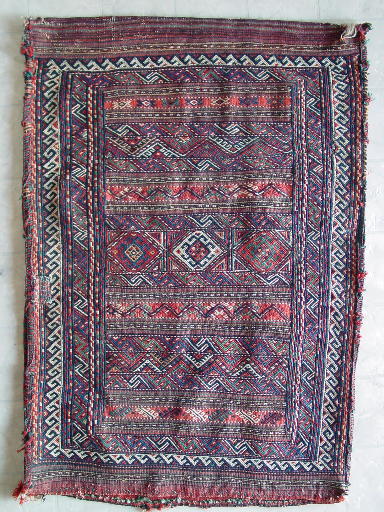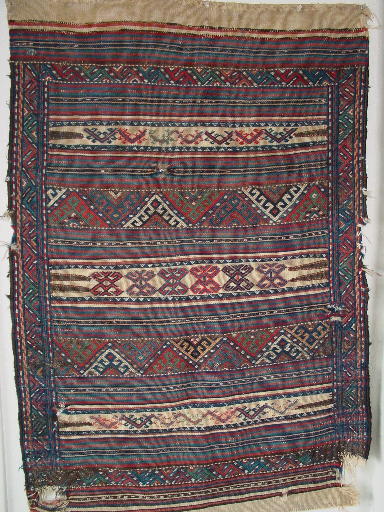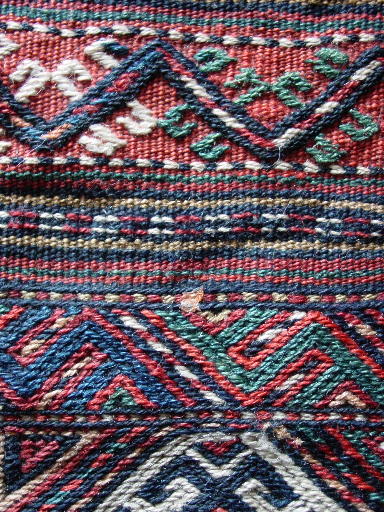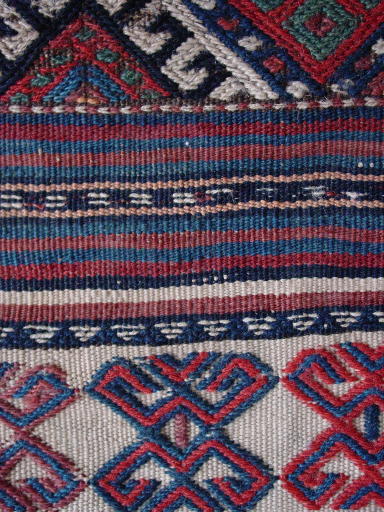Posted by Patrick Weiler on 08-22-2004 12:16 AM:
Kordi Kouple
Here is a pair of Kordi flatweaves.
The first (acquired earlier) is a
"grain bag", complete with back . It has been attributed to the Kordi of
northeastern Iran, circa late 19th century.

The second is similar in size, but
different in design. It has the typical "backgammon" motifs common to soffreh
weavings. It, too, is a Kordi weaving.

The second piece is lacking the
"running dog" or "wave" outer border.
The second piece is considerably more
worn, although the first piece does have a couple of field patches of later
vintage, one of which can be seen in the outer border on the left side at the
middle, and is more finely woven.
Which would you consider older? As King
Solomon, which would you keep?
Is the second piece actually a soffreh and not a grain bag?
It has no back, but only the top is finished. The top edge is folded over and
sewn down. The bottom edge has been cut. It also has an unusual motif in the
center panel.
In the mid 90's, there were "copies" made similar to the
first piece that showed up on the retail market. Other than pristine condition,
less fine weave and cruder construction they were nearly indistinguishable. Was
the publication of the book Kordi by Stanzer in late 1988 responsible for this
wave of copies?
There was an upsurge in Kordi weavings in the mid to late
90's that included extremely fine versions of various Persian designs, including
Qashqai, that showed up in the American market many years before the embargo was
lifted. Mashad, quite close to the Afghan border, may have been the source of
these weavings which could have been smuggled into Afghanistan on their way to
Pakistan.
Patrick Weiler
Posted by Filiberto Boncompagni on 08-22-2004 04:05 AM:
Hi Patrick,
My preference goes to the second one, in spite of its worn
conditions. I find its design more beautiful and original.
The colors look
better too.
As for the age, I would be inclined to think that the first
one is younger…
I don’t know the answers to your other questions,
sorry.
Regards,
Filiberto
Posted by Patrick Weiler on 08-22-2004 07:46 PM:
Filiberto,
The top piece has approximately 16 sumak wefts per inch,
compared to approximately 10 per inch for the second piece. One reason for the
more striking appearance of the second piece is the three white ground panels,
but the white is all open space with a small amount of sumak designs on
it.
The first piece has a 6" middle section or panel densely covered with
sumak, and striped bands approximately 3" above and below it with sparse sumak.
Then there are 4" bands of dense sumak and another 3" band of sparse, striped
sumak at each end.
The second piece has a center 9" band of sparse sumak,
bordered above and below by a 3" band of dense sumak and another 9" band at
either end of sparse sumak. The densley woven sections are the panels with the
half-latchooks.
In other words, the first piece is covered with much more
time-consuming sumak work and the sumak is finer by more than 50%.
There
may have been a reason for less complex weaving on the second piece, but I do
not know. The usual reason for less complexity is that it is a later weaving.
The design became simplified over time, easier to manufacture.
I kind of
like the fragmentary condition of the second piece. It gives the piece a look of
hard use and authenticity. And it is certainly nice to have a pair of similar
weavings to compare with each other.
I will submit a couple of closer
views for better comparison.
Patrick Weiler
Posted by Patrick Weiler on 08-24-2004 01:05 AM:
Here are two closer views of the two pieces.
The first piece here is a
5" view of the first bag:

This second photo is a 7" view of the second piece:

The weave appears
quite similar in these photos because the first photo is closer than the second,
which was taken from a bit farther away. You can see that the stripes in the
first piece are narrower and the colors are crisper. The details are finer and
there is greater variety.
Not that I would discard either of them. It is nice
to have both of them at hand to compare with each other.
And I still do not
know if the second weaving is a soffreh or not!
Patrick Weiler
Posted by Filiberto Boncompagni on 08-24-2004 03:26 AM:
Hi Pat,
Even if the first one has a finer weave, I still prefer the
second… Which, yes, could be a sofreh.
(Have you checked for ketchup or
mustard stains?) 
Regards,
Filiberto





